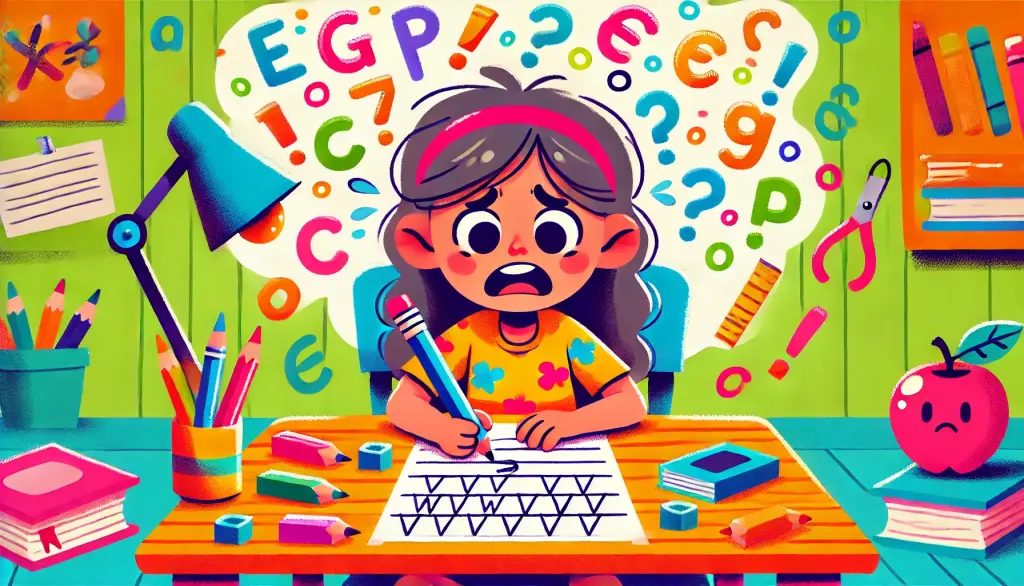
Symptoms of handwriting difficulties in children
Handwriting is a fundamental skill that supports children’s academic success and effective communication. However, some children struggle to develop smooth, legible, and comfortable handwriting, resulting in frustration, reduced academic performance, and lower self-esteem. Recognizing early signs and symptoms of handwriting difficulties helps parents, teachers, and specialists provide timely support to children, fostering improved academic outcomes.
Understanding handwriting difficulties
Difficulties with handwriting, sometimes diagnosed as dysgraphia, result from neurological coordination issues related to fine motor skills, spatial awareness, and motor coordination. While handwriting problems can vary among children, there are consistent signs educators and parents should notice.
Common symptoms of handwriting difficulties
1. Poor letter formation
- Letters are improperly shaped, distorted, or inconsistent.
- May have difficulty starting or ending letters in appropriate places.
- Letters appear reversed, rotated, or mirrored frequently beyond the expected age (e.g., persistent reversal after age 7).
2. Inconsistent sizing and spacing
- Letters and words exhibit irregular sizing, spacing, or positioning on lines.
- Words appear squished together or overly spaced apart.
- Difficulty maintaining margins or staying within lines.
3. Illegible handwriting
- Handwriting is challenging or impossible to read, even by the child who wrote it.
- Illegibility may worsen under time pressures or fatigue.
4. Difficulty writing within lines or margins
- Child's writing consistently "floats" above or below lines.
- Persistent inability to align words or sentences horizontally.
5. Awkward pencil grip
- Unusual or inefficient grips, often holding the pencil very tightly or loosely.
- Holding pencil too high or too low, causing discomfort or fatigue during writing tasks.
6. Slow laborious writing
- Writing projects, assignments, or notes take a significantly longer time to complete.
- Produces less written work compared to peers due to slow speed.
7. Avoidance or resistance
- Actively avoiding writing tasks, homework, journaling, or classroom notes, due to frustration or embarrassment.
- Frequent complaining about hand pain, fatigue, or discomfort during handwriting activities.
8. Unusual body or paper positioning
- Bends wrist excessively, leans too close to paper, or maintains awkward arm, wrist, or posture positions during writing.
- Rotates or tilts paper unusually (beyond slight tilts) while writing.
9. Frequent erasures or cross-outs
- Excessive efforts to correct or redo letters, due to dissatisfaction with handwriting.
- Persistent difficulty in producing meanings or desired results, leading to repeated attempts.
10. Problems copying written material
- Difficulty accurately and timely copying from board, book, or other texts.
- Frequent loss of place when copying.
11. Poor performance on tasks requiring written communication
- Avoids or excessively struggles with essays, short-answer responses, responding on worksheets or written tests.
- Writes significantly less content in tests than verbally communicated responses indicate.
Why early identification matters
Early handwriting assessments are key to supporting student success. Identifying difficulties quickly allows for timely intervention, preventing problems from impacting academic progress, self-esteem, classroom participation, and emotional well-being.
When and whom to consult for support
If a child frequently exhibits several symptoms highlighted above, it is important to involve specialized professionals such as occupational therapists, school psychologists, pediatricians, or specialized teachers. Specialists can perform comprehensive evaluations, identifying underlying causes and formulating effective solutions tailored to the child's strengths and specific needs.
Supporting children with handwriting difficulties
Receiving proper support markedly improves children's handwriting abilities, bolstering academic performance and self-confidence. Some beneficial approaches include:
- Targeted occupational therapy interventions: Therapists develop tailored plans to strengthen hand muscles, improve motor coordination, and use adaptive strategies.
- Classroom accommodations and modifications: Providing extended timelines, task breakdowns, digital assistance, specialized paper, or pencils significantly reduces writing-related stress.
- Multisensory learning techniques: Techniques such as "writing" letters in sand, finger painting, or tracing letter-shapes encourage physical memory of letter formation.
- Promoting clear letter formation by teaching and modeling each letter step-by-step. Handwriting worksheets help reinforce this practice.
In summary
Awareness is the first step towards effective intervention. Recognizing the common symptoms of handwriting difficulties empowers parents and educators alike to step forward proactively, ensuring students receive essential guidance and support. With timely intervention, structured strategies, and continued encouragement, children can significantly improve handwriting proficiency and move confidently forward in their learning journey.
